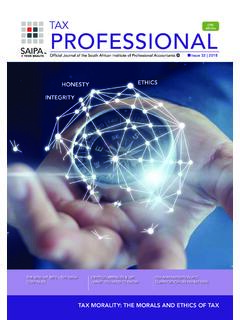Transcription of Risk Management - SAIPA
1 Risk ManagementSeminar June 2017 Compiled by:Raaghieb Najjaar, Yaeesh Yasseen & Rashied SmallDefining RiskRisk Management -June 20172 Risk reflects the chance that the actual event may be different than the planned / expected event. The effect of an uncertainty that could have a negative impact on achieving the business objectives. Upside risk the uncertainty of the possibility of making gains (potential opportunities) Downside risk -the probability that losses or negative outcomes will occur (mitigate negative outcomes) brain Teaser #1 Discuss whether the following represents a risk to the organisation budgeted an annual amount of R million for salaries and wages. The actual expenses incurred amounted to R 4 organisation budgeted and amount of R 26 million for revenue. The accounting recorded reflected an annual revenue of R 31,2 million. business owner is prepared to take any income generating opportunity irrespective of the potential business organisation strategic objectives is to maximise Management -June 20173 Hierarchy of RiskRisk Management -June 20174 brain Teaser #2 Discuss whether the following statements are True / organisation with no strategic objective or goal seldom encounters risk in its business organisation with a clearly defined strategic objective is more likely to manage potential risk.
2 Potential for risk occurring at operational level is often attributed that managers do not take accountability. Risk Management -June 20175 Understanding RiskRisk Management -June 20176 brain Teaser #3 Discuss whether the potential risks and/or challenges encountered accounting organisation conducting business locally and internationallyRisk Management -June 20177 Types of RisksRisk Management -June 20178 Business/Operational Risk:-Strategy risk-Product risk-Operating riskFinancial Risk:-Cash flow risk-Credit risk-Liquidity risk-Interest rate risk-Currency riskEnvironmental Risk:-Political risk-Economical risk-Social risk-Technological riskReputational Risk:Enterprise RiskRisk Management -June 20179 Types of Business RisksRisk Management -June 201710 Business RisksRisk Management -June 201711 Internal Operational RisksRisk Management -June 201712 Operational RiskPeopleSkills / CompetenceTrainingAbsenteeismProcessesQu alitative riskCRM -satisfactionQuantitative risksEffectiveness riskEfficiency riskTechnologyChanges / outdated FunctionalityExternal RisksRisk Management -June 201713 External riskFinancingRegulatory environmentReputationCompetitionStakehol dersNatural disasterBrain Teaser #4 Discuss and rate (scale of 1 10) the external risks encountered by the Professional Accountant.
3 Risk Management -June 201714 External riskFinancingRegulatory environmentReputationCompetitionStakehol dersNatural disasterRisk Management Risk Management refers to the process designed to reduce or eliminate the risk of certain kinds of events happening or having an impact on the business -process for identifying, assessing and prioritizing risks . Enterprise Risk Management is defined as a process, effected by an entity s board of directors, Management and other personnel, applied in strategy-setting and across the enterprise, designed to identify potential events that may affect the entity, and manage risk to be within its risk appetite, to provide reasonable assurance regarding the achievement of entity objectives. -COSORisk Management -June 201715 ERM Strategic Level Risk Management -June 201716 These are the high level goals that are aligned with and support the institution s Operations LevelRisk Management -June 201717 Relate to the ongoing Management process and daily activities of the Reporting LevelRisk Management -June 201718 Relates to the organization s adherence to applicable laws and Compliance LevelRisk Management -June 201719 Relates to the protection of the organization s assets and quality of financial Operations LevelRisk Management -June 201720 The Internal Environment relates to the general culture, values and environment in which an organization or entity operates ( tone at the top)
4 Risk Management ModelRisk Management -June 201721 Risk Management ProcessRisk Management -June 201722 Establishing the Risk Context Establish the context by identifying the objectives of the project, event or relationship and then consider the internal and external parameters within which the risk must be managed. Establishing the context sets the framework within which the risk assessment should be undertaken, ensures the reasons for carrying out the risk assessment are clearly known, and provides the backdrop of circumstances against which risks can be identified and assessed. Risk Management -June 201723 Establishing the Risk Context Set the scope for the risk assessment by identifying what you are assessing Define the broad objectives and identify the reason for the risk assessment Identify the relevant stakeholders, the areas that might be impacted and seek their input -inclusive process Gather background information by ask the right people and identify the information that is available as well as information that is not available (immediately) but may be necessary Risk Management -June 201724 Establishing the Risk ContextWhen gathering information consider.
5 Strategic & business plans Reports such as financial statement, inspections, site visit Personal experience of staff Corporate knowledge & institutional memory Previous event investigations or reports Surveys, questionnaires and checklists Insurance claim reports Business experience (local or international) Structured interviews or Focus group discussion Historical records Risk Management -June 201725 Context of Risk -Business ModelRisk Management -June 201726 brain Teaser #5 Identify possible risks associated with each of the segments in the business model:Risk Management -June 201727 Market segmentChannels of deliveryResources/capacityOperational segmentRisk Assessment Business ModelRisk Management -June 201728 Porter s 5 ForcesRisk Management -June 201729 Establishing the Risk ContextRisk Management -June 201730 Identification of Risk Risk identification involves identifying sources of risk, areas of impact, events and their causes and consequences -risk of doing nothing and missing an opportunity Identify sources of the risk, areas of impact, events (including changes in circumstances) and their causes and potential consequences Describe those factors that might create, enhance, prevent, degrade, accelerate or delay the achievement of your objectives.
6 Risk Management -June 201731 Identification of RiskQuestions to identify riskWhat could go wrong?What caused the risk?Where did it happen?Why did it happen?What is the impact?Who owned the risk?Risk Management -June 201732 Identification of RisksRisk Management -June 201733 Identification of Risk Identify risks early in the process or project Identify risks in an iterative and holistic manner Identify risks with a consistent frequency ongoing and regularly Identify risks when change control is performed Identify risks when major milestones are achievedRisk Management -June 201734 Identifying RisksRisk Management -June 201735 Identification of RiskRisk Management -June 201736 SWOT AnalysisRisk Management -June 201737 PEST AnalysisRisk Management -June 201738 Delphi MethodRisk Management -June 201739 brain Teaser #6 Professional Accountants performing the compilation, review or audit of financial statements use the following statement extracted from the relevant report included in the financial statements to limit their risks when business faces financial and business risk.
7 The preparation of the financial statements set out on pages 3 to 13 are the responsibility of the member. We have ascertained that the financial statements are in agreement with the accounting records, summarized in the manner required by section 58(2)(d) of the Act, and have done so by adopting such procedures and conducting such enquiries in relation to the books of accounts and records as considered necessary in the circumstances. Discuss the possible reasons why the Professional Accountants may be held liable for the financial and business risks faced by Management -June 201740 Identification of Risk -PitfallsRisk Management -June 201741 risks are not identified early when it is less expensive to address risks are not identified in an iterative manner Risk are not identified with appropriate stakeholders Risk are not identified using a combination of risk identification techniques risks are not captured in one location risks are not visible and easily accessible.
8 risks are not captured in a consistent format ( , Cause -> Risk -> Impact).Analysis of RiskRisk Management -June 201742 Risk analysis is the systematic study of uncertainties and risks encountered in business and many other areas. Risk analysts seek to identify the risks , understand how and when they arise, and estimate the impact (financial or otherwise) of adverse outcomes. This technique also helps to define preventive measures to reduce the probability of these factors from occurring and identify countermeasures to successfully deal with these constraints when they develop to avert possible negative effects on the competitiveness of the of RiskRisk Management -June 201743 LikelihoodImpactRankingAssess the likelihood of the risk occurring measuring the probability of occurrenceAssess the consequence/impact if the risk occurred measuring the frequency or severity The risk matrix then determines whether the risk rating is low, medium, high or extreme Types of RisksInherent RiskThe risk that an activity would pose if no controls or other mitigating factors were in place (the gross risk or risk before controls)
9 Control RiskRisk of loss arising from internal control systems to lose their effectiveness and thus expose or fail to prevent exposure of the objective they were to RiskRisk to detect a material misstatement in the financial RiskThe risk that remains after controls are taken into account (the net risk or risk after controls). RisksRisk Management -June 201744 Residual RiskRisk Management -June 201745 Analysing risks -MethodsRisk Management -June 201746 Risk Impact Assessment Risk impact assessment is the process of assessing the probability (likelihood) and consequences of the events if they are realised. The results of the assessment are used to prioritise risks to establish a most-to-least critical importance Management -June 201747 Risk Impact AnalysisRisk Management -June 201748 Risk Analysis MatrixRisk Management -June 201749 brain Teaser #7 Risk Management -June 201750 Risk RatingDescriptionLikelihood occurrence1 Rare2 Unlikely3 Possible4 Likely5 CertainRisk Likelihood DescriptorRisk Management -June 201751 Risk RatingDescriptionLikelihood occurrence1 RareHighly unlikely, but it may occur in exceptional circumstances, but probably never will2 UnlikelyNot expected, but there is a slight possibility it may occur at some time3 PossibleThe risk might occur at some time as there is a history of casual occurrence inthe business or similar businesses (industry)4 LikelyThere is a strongpossibility the risk will occur as there is a history of frequent occurrence in the business or similar businesses (industry)
10 5 CertainVery likely as the risk is expected tooccur in most circumstances as there is a history of regular occurrence in the business or similar businesses (industry) brain Teaser #8 Risk Management -June 201752 Risk RatingDescriptionFinancial impactBusiness interruptionReputational impactBusiness objective1 Insignificant2 Minor3 Moderate4 Major5 CatastrophicRisk Likelihood DescriptorRisk Management -June 201753 Risk RatingDescriptionFinancial impactBusiness interruptionReputational impactBusiness objective1 InsignificantMinimal financial lossNegligible as risk does not affect operationsNegligible impactexternallyResolved as part of day-to-day Management activities2 MinorLimited loss exposureInconvenient to function of operationsAdverse effect which may impact on customersMinor impact which require investigation3 ModerateAcceptable loss exposureLimited disruption to the operationsDirectlyaffecting customer relationshipsSignificant impact which require Management intervention4 MajorNegative impact of performanceSystems failure which causes temporarydisclosureNegativelyaffect the reputation of the businessMajor impact which














